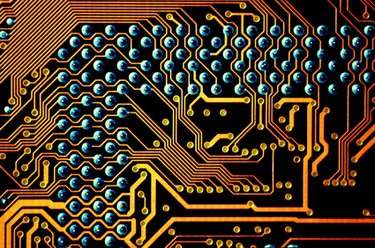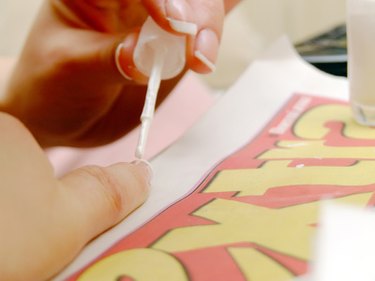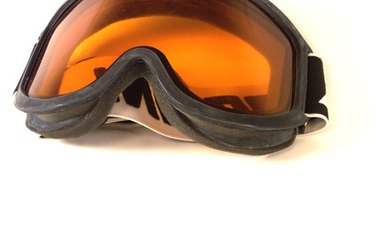
A simple etchant can be made from common chemicals found at local hardware stores. Hydrochloric acid, also known as muriatic acid, is generally used to clean concrete foundations or patios. A pattern is either transferred or printed onto a 3 1/2-by-5 inch circuit board. The circuit board is made of copper that covers an insulator. Any indelible marker will work to trace a pattern onto the board, but some people prefer using a thin permanent marker to control the thickness of the lines drawn. The pattern could be transferred by ironing a copy of the pattern printed on photo paper. You would need to make a separate copy of the front and back of the pattern and iron the front to one side and the back on the flip side.
Step 1

Draw or iron a transfer of your pattern onto the circuit board. If you draw directly onto the circuit board, wipe off mistakes with a 1-to-1 mix of acetone and alcohol, then start over.
Video of the Day
Step 2
Put on the goggles and vinyl gloves before mixing the chemicals. In a large nonmetallic bowl or container, mix 1 part hydrochloric acid with 2 parts hydrogen peroxide. For example, you would use 1 cup of the acid to mix with 2 cups of the peroxide.
Step 3

Slowly add the acid to the hydrogen peroxide. Never add the hydrogen peroxide to the hydrochloric acid, as it could cause a reaction that might splash the chemicals into your face.
Step 4

Mix enough chemical solution to totally submerge the circuit board. Agitate the board in the solution for 10 to 15 minutes, using a pair of nonmetallic tongs.
Step 5
Mix the acetone and rubbing alcohol together. Dip a paper towel into the solution and wipe both surfaces of the circuit board to stop the etching process and remove any remaining lines from the marker.
Step 6
Dispose of the etchant properly or store the solution in a glass or plastic container with a lid. Mark the contents of the container and store it in a responsible place out of heat and excess light and out of reach of children.
Video of the Day